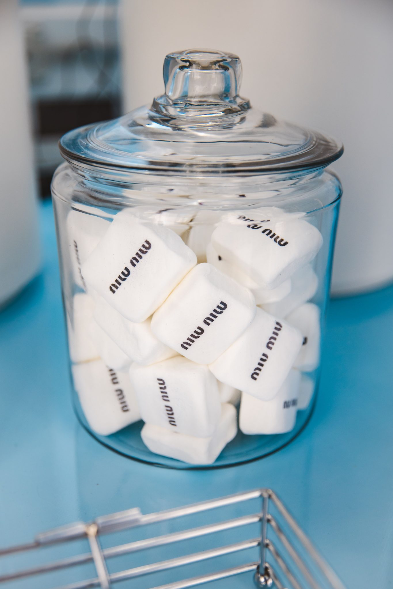The Irresistible Rise of Food-Inspired Marketing. A sensory revolution rooted in consumer behavior
When did branding start tasting so good?
What began as an occasional flirtation with food in advertising has become a full-blown sensory revolution. Today, brands don’t just sell products — they serve experiences. They’re dripping honey on lip balms, layering croissants beneath handbags, embedding perfumes into peaches, and launching skincare campaigns that look more like dessert
It’s not just beautiful. It’s behavioral.
Let’s start with the science: sensory branding taps into how we choose.
Consumer behavior is deeply rooted in multisensory experiences. We don’t buy rationally, we buy emotionally, intuitively, and often viscerally.
In fact, according to Lindstrom’s Brand Sense,
83% of all communication is processed through our senses.
Brands that engage more than one sense are more likely to be noticed, remembered, and preferred.
That’s why the visual ‘foodification’ of products works so well. It shortcuts logic and hits desire. Think about it: a luxury lip balm that looks like caramelized sugar. A high-fashion ad featuring an egg, ripe and ready to crack. A serum that melts like chocolate. These aren’t random creative choices — they’re calculated strategies to trigger the limbic system, the part of the brain responsible for emotion and memory.
The power of sensorial design: when beauty meets appetite
What if the secret to unforgettable branding wasn’t in your product — but in your taste?
Today’s most captivating brands aren’t just seen. They’re felt. Tasted. Craved.
From lip balms that look like frosting to perfumes dressed in juicy fruit metaphors, we’re watching a new creative era unfold — one where design seduces through the senses.
It’s not just visual identity anymore. It’s sensorial identity.
This is more than clever art direction. It’s emotional strategy.
Because appetite isn’t just physical — it’s emotional. And brands that tap into that craving aren’t just liked. They’re longed for.
In a sea of sameness, sensory design doesn’t whisper. It melts, drips, glows. It stays.
These aren’t product photos. They’re cravings in disguise.
By associating products with food — the most primal source of pleasure and comfort — brands are hacking consumer instincts. The textures, colors, and materials are edible in all but taste. It’s marketing that seduces, not shouts.
Seducing the Senses: A Look at Sensory Branding in Luxury
Luxury branding has always been about storytelling. But today, it’s not just about the story — it’s about how it feels, smells, tastes. Welcome to the era of sensorial seduction, where brands don't just show their value — they make you feel it on your skin, tongue, and memory.
Tom Ford’s Bitter Peach: Pleasure Bottled
Few brands understand desire like Tom Ford. The Bitter Peach campaign isn’t a fragrance ad — it’s a visual feast. Juicy, dripping peaches sliced open to reveal their flesh. It’s lust in edible form. This isn’t about top notes and heart notes — it’s about emotional notes. The peach becomes a metaphor: ripe, dangerous, unforgettable. A perfume you don’t wear — you devour.
Rhode’s Glazing Milk: Skin That Looks Like Dessert
Hailey Bieber’s Rhode doesn’t just sell skincare — it sells craveability. Glazing Milk looks like frosting, feels like silk, and photographs like temptation. The visuals? Swirls of cream, dewy drops, syrupy drips. The result? You want to lick it off the screen. Rhode taps into a powerful idea: beauty that looks good enough to eat is beauty that sells. Call it skincare, call it dessert — consumers call it irresistible.
Jacquemus: Invitations You Can Eat
Only Jacquemus could turn a fashion show invitation into a sensory event. Forget paper. Think butter. Think baguette. A literal taste of the brand. By fusing the visual with the edible, Jacquemus extends its brand into your mouth and memory. It’s branding you don’t just remember — it lingers. In your palate, your fingers, your Instagram feed.
And just when you thought it couldn't get more decadent, Jacquemus served jewellery you could almost spread on toast.
Jacquemus Golden Croissants: The Taste of Wearable Desire
Jacquemus didn’t just design earrings, he plated indulgence. These miniature golden croissants are more than fashion; they’re appetites cast in metal. A sensory wink to French mornings, warmth, and pleasure — transformed into luxury.
By turning a universal comfort food into a tactile, wearable form, the brand collapses boundaries between adornment and emotion. It´s like don’t just wear Jacquemus,you crave it.
SKIMS Waffle Drop: Clothes That Comfort Like Breakfast
SKIMS doesn’t just sell softness — it sells emotional comfort. And with the Waffle Collection, it tells the story visually and texturally. Waffles are warm. Familiar. Safe. So is shapewear that hugs without suffocating. The brand’s food-inspired visuals whisper: “this isn’t just clothing — it’s self-care served hot.”
Chanel La Crème Main: An Egg of Luxury
Chanel took a hand cream and turned it into an object of art. And then wrapped it in a metaphor — the egg. Smooth. Protective. Fragile. Precious. By showing the cream nestled among real eggs, Chanel creates an unspoken promise: this is care, not product. This is softness, not skincare. Luxury doesn’t shout. It caresses.
Loewe x Nature: The Tomato as Muse
Loewe gave us tomatoes and bricks — and made it feel like sculpture. Their sensorial minimalism makes fashion feel fresh, raw, real. The tomato? It’s alive. The brick? Solid. Together, they whisper authenticity, craftsmanship, simplicity. It’s not about luxury through excess — it’s luxury through restraint. Through senses awakened.
Chloé: Juicy Femininity, Served Raw
With Chloé, the fruit isn’t just a metaphor — it’s a manifesto. This split papaya, one side filled with seeds, the other with tangled gold and pearls, turns softness into power and ripeness into luxury. It’s sensuality without cliché. Nature meets ornament. Flesh meets fashion. The contrast — glistening pulp and heavy jewels — tells a story of modern femininity: organic, bold, and unapologetically rich in texture. In a world of polished campaigns, this one bleeds truth. You don’t just admire Chloé — you feel it pulse.
They’re serving experiences. Multisensory, unexpected, craveable.
In a world numb with noise, emotion cuts through. Texture lingers. Flavor connects. Touch convinces.
Why Luxury Leads the Sensory Shift
It’s no coincidence that luxury brands are at the forefront of this sensory renaissance. When price is no longer the differentiator, feeling becomes the value. High-end houses like Tom Ford, Jacquemus, Loewe, and Chloé understand that desire is built in the senses — not the specs. Their audiences don’t buy out of need; they buy out of emotion, ritual, seduction. Sensory branding becomes a shortcut to intimacy. It slows down the scroll, triggers instinct, and creates the kind of longing that logic can’t touch. For luxury, selling is no longer the goal. Craving is.
Brand connection doesn’t begin with logic — it begins with longing. Want loyalty? Start with the senses.
From visuals to full-on sensory immersion
But for some brands, the image isn’t enough. They're going further — beyond visuals, into full-blown sensory immersion.
We’re seeing a rise in activations that blend food, fashion, and luxury to create real-world, Instagrammable brand moments that live beyond the scroll.
Gucci launched Lido Ice Cream
At Bangkok’s Siam Paragon, Gucci launched Lido Ice Cream, a pastel-hued gelato experience that brought the brand’s Riviera collection to life through flavor. Not in a store. Not on a billboard. On a cone.
Miu Miu – Gelato Hits the Streets
Also on the sensorial gelato world, Miu Miu launched branded truck. Well, more like a sugar-coated invitation.
The brand rolled through Paris with a pastel-pink gelato cart, handing out frozen treats in delicate, logo-wrapped packaging. No sales pitch. Just a moment of pure indulgence.
Why does it work? Because it taps into something primal — the joy of surprise, the pleasure of sweetness, the nostalgia of summer.
It's not about ice cream. It’s about forging real-time connection through shared ritual. A brand that doesn’t just exist on fabric, but melts into memory.
Magnum – Design Your Desire
Magnum went even deeper, launching a Foodie Pop-Up in Shoreditch, London. In the heart of Shoreditch, Magnum didn’t open a pop-up. They built a temple of temptation.
At the Foodie Pop-Up, customers were invited to design their own luxury: select the chocolate, pick the toppings, feel the crunch.
Every detail was tactile. Every choice personal. Every bite — a branded emotion.
Why does it work? Because today’s consumers don’t just want to consume. They want to co-create. To experience. To taste what the brand feels like.
Magnum – Multi-Sensory Immersion
At Manchester’s Printworks, Magnum didn’t just launch an activation — they orchestrated a seduction.
Lights. Scents. Music. Texture. A multisensory choreography designed to envelop you in indulgence.
The brand came alive in 360º. You didn’t just see it — you felt it, smelt it, heard it.
In 2025, attention is a currency. But immersion? That’s loyalty.
Magnum didn’t speak to consumers. They whispered to their senses.
The new rules of brand desire
We’re entering a new era of branding. One where consumer value isn’t driven by utility or status alone, but by how deeply a brand resonates on a sensory and emotional level. Where every campaign is not just seen, but felt. Where value is tied to moments, not just margins.
In this food-inspired landscape, branding is no longer about standing out on the shelf — it’s about staying on the tongue, the skin, the heart.
Sensory branding isn’t a gimmick. It’s a strategy rooted in the truth of human behavior: we are driven by what we can touch, smell, taste and feel.
The brands that win? They don’t just get under your skin — they flavour your entire experience.
“As you might imagine, our brains are adept at filtering out irrelevant information. Emotion gets out attention through our senses-which then influence out decision-making processes. Brands that create an emotional connection to consumers are much stronger than those that don't- it's as simple (and complicated) as that.”
― Martin Lindstrom | Brand Sense: Build Powerful Brands through Touch, Taste, Smell, Sight, and Sound
















